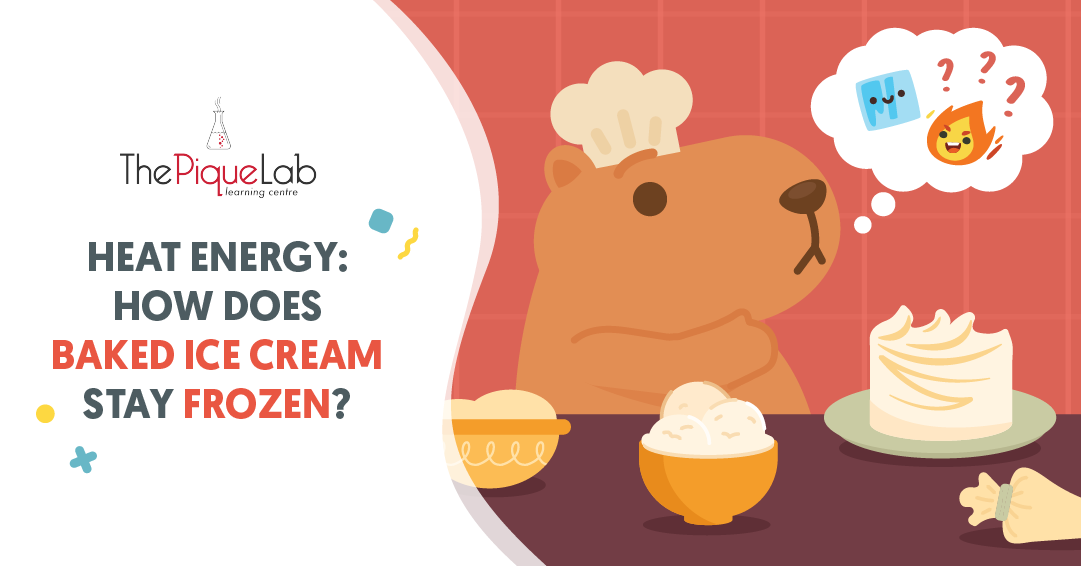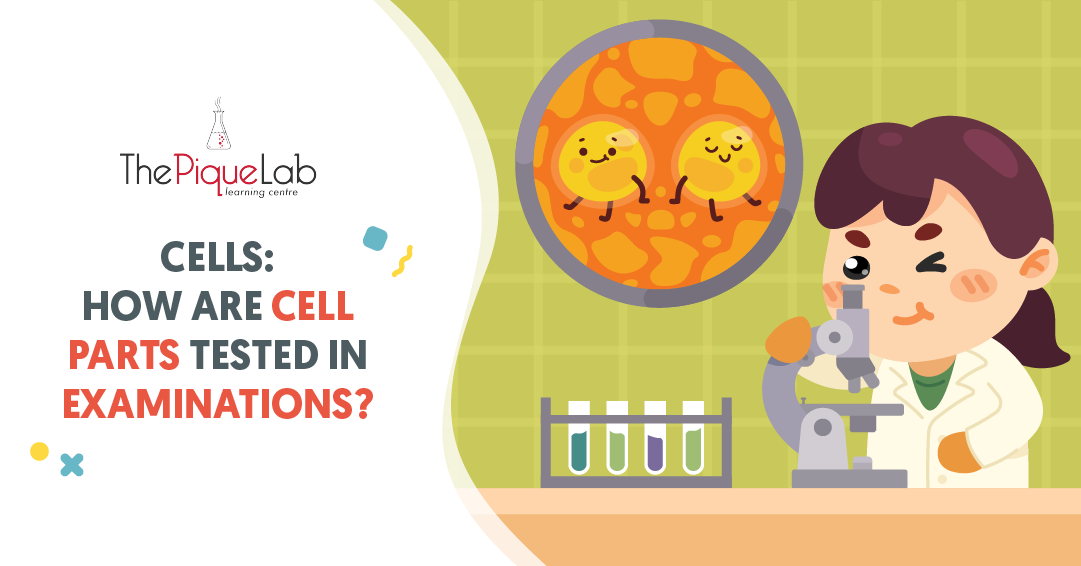Do you have a sweet tooth like I do?
During the holidays, I went café-hopping to try many yummy desserts! There was one dessert that really stood out to me and it is called baked Alaska. Since the name of the dessert was so intriguing, I decided to order it.
For those who may not know, baked Alaska is an old-school dessert that consists of a layer of cake, a frozen ice cream centre and a coating of toasted marshmallow meringue, as shown in the picture below.

When I bit into the baked Alaska, I was pleasantly surprised! The dessert was baked in a piping hot oven but the ice cream on the inside was still frozen. It made me wonder how the ice cream on the inside of the baked Alaska could stay frozen despite being baked in the oven. What do you think is the reason?
To answer this question, I have selected a Heat Energy question from the 2021 Rosyth School (ROSYTH) P6 SA2 Examination Paper for discussion.
Read Also:
Question Analysis

Source: Rosyth School – 2021 P6 SA2 Examination Paper [Q36]
Thought Process
In part (a), the question mentioned that the air bubbles in the foamy layer prevented the ice cream below it from melting when placed in the hot oven (refer to the diagram below).

As such, if there were no air bubbles in the foamy layer above the ice cream, what do you think would have happened to the ice cream when placed in the hot oven? The ice cream would have melted.
“When placed in the hot oven, why would the ice cream melt when there are no air bubbles in the foamy layer above the ice cream?”
The cold ice cream would need to gain heat for it to melt. Where would the cold ice cream gain heat from?
Recalling that “heat travels from a warmer region to a cooler region”, this means that the cooler ice cream has to gain heat from a warmer region. In this question, the warmer region is the hot air inside the oven.
🍦 From the diagram below, the cold ice cream in the hot oven would have to gain heat from the warmer air in the hot oven to melt.

With this understanding, we are ready to find out how the air bubbles could have prevented the ice cream from melting.
Let’s Analyse Part (A)
“What is the property of heat of the air bubbles that prevented the ice cream from melting when placed in the hot oven?”
Now, I know what some of you might be thinking:
As discussed above, for the ice cream to melt, the ice cream would have to gain heat from the warmer air in the hot oven.
This means that to prevent the ice cream from melting, the air bubbles must have prevented the ice cream from gaining heat from the warmer air in the hot oven.
“Is it correct to say that the air bubbles prevent the ice cream from gaining heat from the warmer air in the oven?”
Definitely not! No material can prevent heat from passing through it.
If there are materials that can prevent heat from passing through them, inventors would have used that material to make a flask. In that case, the hot drink stored inside that flask will remain hot forever! 👏
But do we actually have such a flask? No!
🍦 Reality: All materials conduct heat. The difference is the rate at which the materials conduct heat!
“As such, to prevent the ice cream from melting, do you think the air bubbles conducted heat from the warmer air in the oven to the cooler ice cream quickly or slowly?”

🫧 To prevent the ice cream from melting, the air bubbles must have conducted heat from the warmer air to the cooler ice cream slowly.
And what is the name given to materials that conduct heat slowly? These materials are known as poor conductors of heat.
To conclude:
“What is the property of heat of the air bubbles that cause them to conduct heat to the ice cream slowly and prevent the ice cream from melting?”
The air bubbles must be poor conductors of heat! We are now ready to write our answer!
Suggested Answer For Part (A)
Air is a poor conductor of heat.
Let’s Analyse Part (B)

Source: Rosyth School – 2021 P6 SA2 Examination Paper [Q36]
“Give a possible reason for the difference in the results of their investigation.”
Firstly, let’s identify the difference in the results.
From the table and the diagrams above, for the thinner 1-cm foamy layer, the time taken for the ice cream to start melting was shorter as compared to the thicker 2-cm foamy layer.
This means that for the thinner 1-cm foamy layer, did the ice cream melt faster or slower, as compared to the thicker 2-cm foamy layer?
🍦 The ice cream melted faster for the thinner 1-cm foamy layer.
And how does the thinner foamy layer cause the ice cream to melt faster? Before we can answer that question, we must first ask ourselves:
“What is the significance of the foamy layer being thinner?”

1-cm foamy layer (refer to the diagram above)

2-cm foamy layer (refer to the diagram above)
As seen from the 2 diagrams above, when the foamy layer is thinner, are there more or less air bubbles trapped inside it?
🫧 There are less air bubbles trapped in the thinner foamy layer, as labelled in the diagram below.
Here comes the next important question:
“How does having less air bubbles cause the ice cream to melt faster?”
To answer the question above, let’s recall the heat property of the air bubbles that we have concluded in part (a).
In part (a), we learnt that air bubbles are poor conductors of heat that will conduct heat from the hot air in the oven to the cooler ice cream slowly, preventing the ice cream layer from melting.
“As a result, when there are less air bubbles, would heat from the hot air in the oven be conducted to the cooler ice cream be faster or slower than when there are more air bubbles?”

🫧 When there are less air bubbles, heat from the hot air in the oven would be conducted to the cooler ice cream faster as shown in the diagram above.
As a result, with less air bubbles in the foamy layer, do you think the ice cream would melt faster or slower?
The ice cream would melt faster and the time taken for the ice cream layer to melt would be shorter, as shown in the diagram below.
With this understanding, we are ready to write our answer!

Suggested Answer For Part (B)
The 1-cm foamy layer is thinner and has less air bubbles than the 2-cm foamy layer.
Since air is a poor conductor of heat, the thinner 1-cm foamy later will conduct heat from the hot oven to the cooler ice cream layer at a faster rate, causing the time taken for the ice cream layer to start melting to be shorter.
Summary
I hope this article has helped you gain a better appreciation of how Science concepts on heat can be used in baking delicious desserts! In fact, without an understanding of these heat concepts, bakers would not be able to make interesting and yummy desserts such as the baked Alaska.
Upon further reading on the baked Alaska, I discovered that the foamy layer of egg white and sugar is called the meringue, which is baked to turn brown in the oven.
In order to introduce air bubbles into the meringue, bakers have to whip the egg whites with a mixer until it becomes foamy. The foam indicates the presence of air bubbles in the meringue layer.
If any of you are interested in making your own baked Alaska at home, you can try out this recipe from The Food Network: https://www.foodnetwork.com/recipes/food-network-kitchen/baked-alaska-recipe-2125603.
Before ending the article, there was another delicious dessert I ate in December called fried ice cream! Do you know how they are made? I would like to challenge all of you to find out more about how these kinds of hot and cold desserts are made! I will give you a hint: there are no air bubbles involved this time.
I hope you enjoyed reading this Heat Energy article and continue to keep a lookout for our new articles!

If you like our methodology, we've some upcoming workshops:








